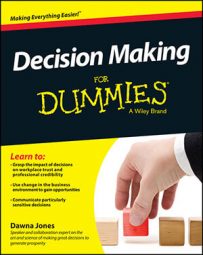In fast-moving, complicated, and unpredictable situations, decision-makers can hesitate because they fear making a mistake or are overwhelmed by uncertainty. Hesitation, once it becomes a habit, weakens personal and organizational confidence. But make no mistake: Doing nothing is a decision. If you choose to do nothing, make sure it is a choice instead of a default position for coping with the unknown.
Factors to consider before deciding not to take action
Like any decision, the decision to do nothing needs careful thought. Here are a few factors to consider before you decide not to take action:
Whether waiting will cost more financially or have a negative impact on key relationships: Reflecting on the financial risks of inaction or delay helps you decide whether doing nothing is really the best option.
Money doesn’t have to be lost all in one big chunk to be harmful to your business’s finances. Some costs occur a little at a time, but over time add up. Although you may be tempted to delay making a decision that addresses the “slow-leak” issue, doing so works against the company’s financial viability.
Whether the problem you are addressing is more serious and likely to scale up or expand if you do nothing: Problems that have a tendency to expand and get worse if ignored include issues like maintenance problems (such as leaky valves), health and safety concerns (such as outdated or improperly functioning machines), interpersonal problems in the workplace (such as bullying, destructive conflict, and infighting), and unethical behavior (theft of supplies or issuing false invoices).
Whatever is tolerated is considered acceptable, and the behavior can escalate as a result. If employees are stealing from the company, bullying others (it happens more often than you think), or behaving in other unethical ways, and management is aware of these issues and takes no action, the company has a serious problem. You need to face the issue.
Whether doing nothing will cause a safety problem: You never want to turn your back on a situation that presents a safety or health concern.
As soon as you are aware of a health or safety risk, doing nothing is irresponsible and could be catastrophic. Taking shortcuts during a construction project may save money, for example, but if it increases the risk of injury to the public, it could lead to civil — and possibly even criminal — suits.
Whether delaying will result in higher social or environmental costs: When a company’s actions negatively affect public health, the situation requires immediate action. Instead of being on the wrong side of the law, companies can remediate the problem or take full responsibility and address the issue.
Don’t assume that only big companies can cause significant environmental damage. Even small companies or single individuals in any size company are capable of making big mistakes that the community or environment pays for. For example, an employee from a lawn-treatment company contracted to spray herbicide may clean his tank and dump the wastewater into the ditch that runs into the community water supply.
When it’s better not to act
Sometimes doing nothing is better than the available alternatives. Doing nothing may be a better option in these situations:
When confusion is greater than clarity: Stress, fear, and doubt wreak havoc with the mind, denying access to the calm emotional state that enables decision-makers to stay receptive to new information. So take time to clear the chatter and calm the nervous system before you decide.
When lack of commitment suggests implementation won’t succeed: If the team isn’t totally committed to the decision and direction, any action or plan may end up being flawed or stalled. In this case, wait until the commitment level is stronger or until the reasons for hesitation become clear and are resolved.
When you detect that something isn’t right: If coworkers or staff exhibit unusual behavior (like declining performance), that may mean pressures from home or addiction issues. In this case, suspend the decision until you know what you are dealing with. Monitor and observe the situation. Then before making a decision or putting your hunches to the test, verify your suspicions by asking questions and checking your facts.
As the preceding list makes clear, sometimes, the best decision is to do nothing. However, make sure that you’re not sticking with the status quo just because it feels familiar and safe.
Some companies seem to believe that by pretending nothing is changing, nothing will. This approach is a risky one. Business conditions are dynamic and unpredictable. As a business leader, you are far better off developing skills that enable you to work in uncertain and unpredictable environments rather than hoping that everything will stay the same or return to the way they were before. The ultimate guide regarding when to wait and when to act is self-awareness.

